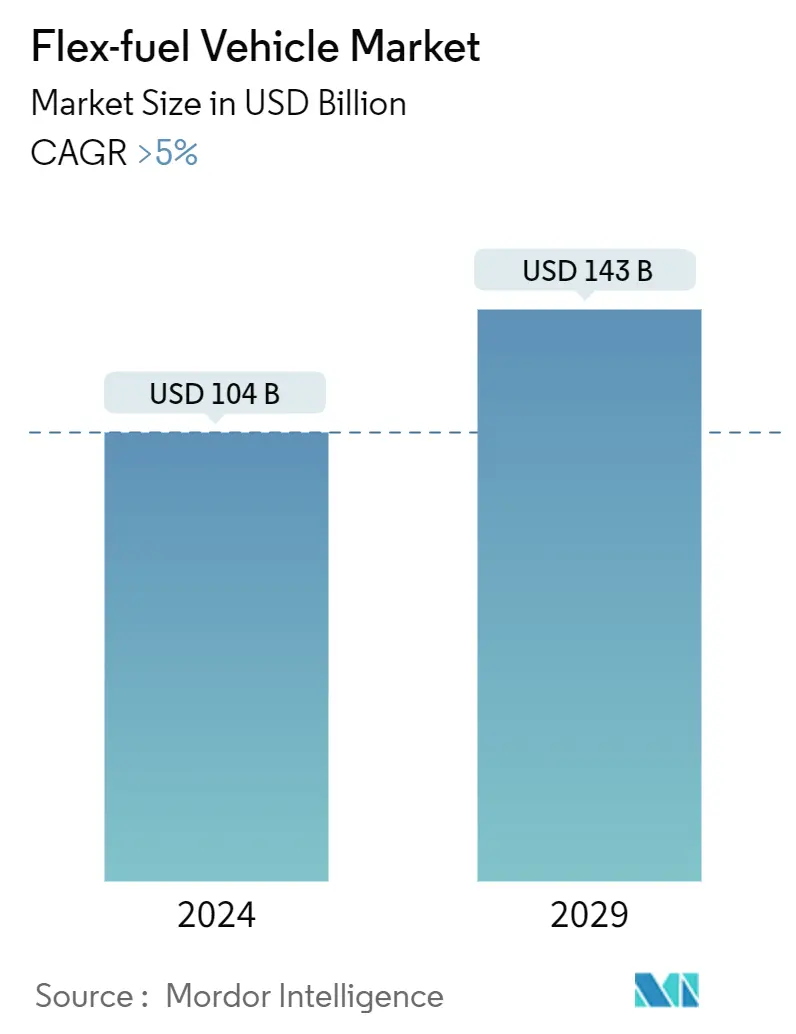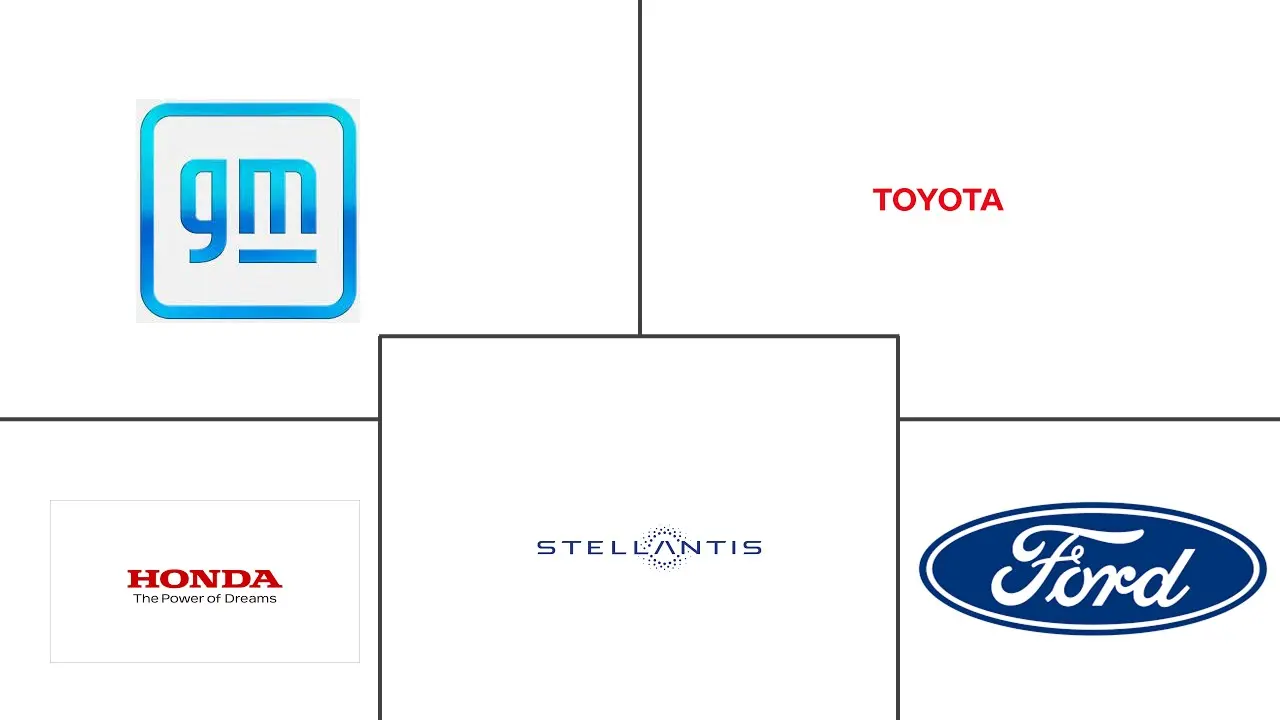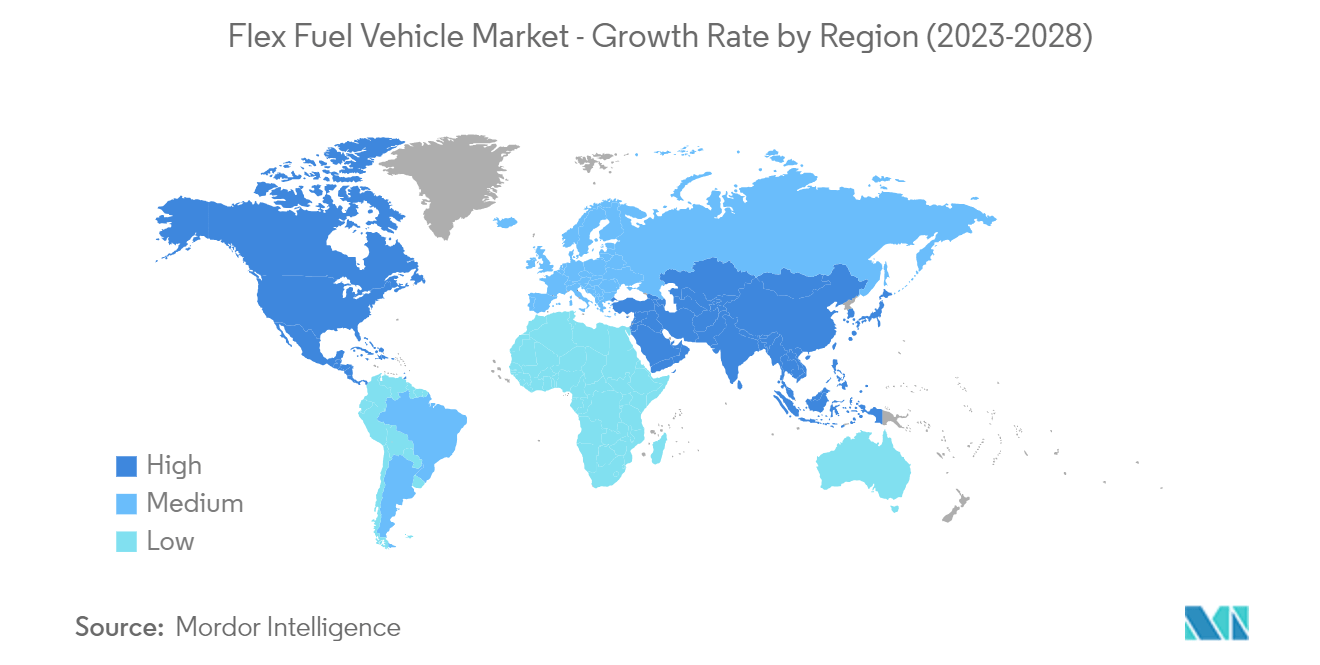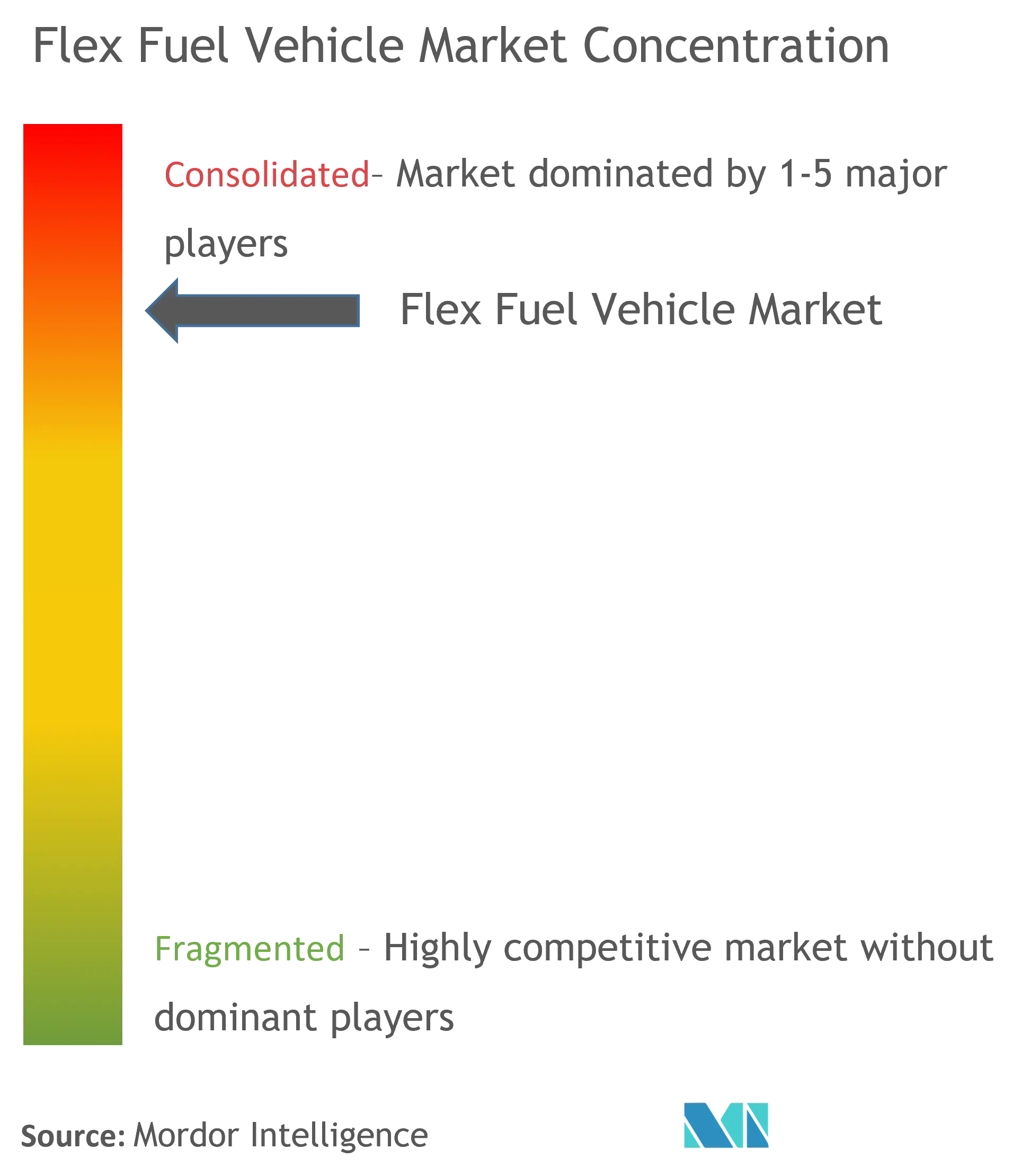Flex-fuel Vehicle Market Size

| Study Period | 2019 - 2029 |
| Market Size (2024) | USD 104 Billion |
| Market Size (2029) | USD 143 Billion |
| CAGR (2024 - 2029) | > 5.00 % |
| Fastest Growing Market | Asia-Pacific |
| Largest Market | North America |
| Market Concentration | High |
Major Players
*Disclaimer: Major Players sorted in no particular order |
Flex-fuel Vehicle Market Analysis
The Flex-fuel Vehicle Market size is estimated at USD 104 billion in 2024, and is expected to reach USD 143 billion by 2029, growing at a CAGR of greater than 5% during the forecast period (2024-2029).
The market for flex-fuel vehicles (FFV) was not impacted by the COVID-19 pandemic as severely as other automotive industries. However, with limited options for an FFV in the market, it did witness a slight decline in sales, considering the restrictions imposed by the respective governments. However, with the situation easing and life returning to normalcy, the FFV market is anticipated to grow during the projected period.
Most of the vehicles running are fueled using conventional fossil fuels, which has led to an increase in toxic exhaust gas emissions. To control vehicular pollution, multiple county governments have put forth several emission restrictions for IC (internal combustion) engine-powered vehicles. These restrictions have opened the scope for research on vehicles running on flex fuels.
In the market, there are various categories and types of FFV from E10 to E85 and above. According to the tests conducted, FFVs running on E85 fuel produce 23% less NOx, 30% less CO, and 4-6% lower CO2. Due to numerous factors, including reduced tailpipe emissions, domestic production capabilities of ethanol-based fuels, and limiting the use of naturally occurring fossil fuels, the demand for FFVs is expected to increase during the forecast period.
The demand for flex-fuel vehicles is growing significantly in the United States and the Latin American region. It is estimated that more than 84% of the world's ethanol is produced by the United States and Brazil.
Flex-fuel Vehicle Market Trends
Ratification of Stringent Exhaust Emission Regulations will Diesel Fuel Type Segment
- The increase in vehicle exhaust emissions from all types of vehicles using fossil fuels has contaminated the atmosphere. The poor air quality has led to an increase in a plethora of serious respiratory diseases. In Europe, vehicular pollution contributes to over 30% of total air pollution, including NOx, VOCs, PM2.5, PM10, and others.
- To bring exhaust emissions under control, country-specific vehicle authorities have barricaded the production of greenhouse gasses like NOx, SOx, and other harmful pollutants from vehicle tailpipes.
- For instance, in Europe, exhaust emission norms have become even more strict over the years. According to the regulatory authority European Environmental Agency (EEA), in Euro 4, launched in 2005, the NOx standards were affixed at 0.08g/km, whereas in 2009, it got reduced to 0.06g/km, and it has remained the same for light passenger cars since.
- Similarly, for CO2 emissions in 2015, standard passenger cars were not allowed to exceed 130g/km of CO2. In 2020, it was revised to 95g/km. The European Commission also targets to reduce this number to 70g/km by 2025.
- The reduced amount of greenhouse gases from the exhaust will have a significant impact on health in the long run. Alongside, this will also allow the flex-fuel market to witness an increase in demand in the upcoming years as it is a clean-burning fuel as compared to conventional diesel.

Asia-Pacific to Witness Significant Growth
- More than 70% of the countries in the Asia-Pacific region currently rely upon the import of fossil fuels to run vehicles. The cost of crude oil and its refinement significantly increases the consumer cost of fuel. With emerging markets like India and China, the Asia-Pacific region is expected to witness significant growth.
- For instance, in India, to curb the consumption of fossil fuels and tone down fuel costs, MoRTH (Ministry of Road Transport and Highways) has put forward various deadlines to introduce ethanol-based fuel in the country. Additionally, India accounts for 2% of the global flex-fuel production, which is not enough to fulfill the country's requirements. Hence, the domestic production of ethanol is targeted to rise from 70 to 150 million liters in the next few years.
- The transport ministry is planning to roll out the use of ethanol-based fuel in phases. E10 production is expected to be in motion from April 2022 and E20 from 2025. Various vehicle manufacturers in the country have also been notified to scale up the research to run vehicles on E10 from April 2023 and E20 from April 2025.
- As flex fuels can be manufactured domestically using renewable materials like sugar cane, the ethanol-blended fuel will reduce the quantity of raw fuel imported, helping reduce the fuel cost for end users.
- With the increase in the availability of ethanol-based flex-fuel, the demand for flex-fuel vehicles may witness significant growth as India is the world's second-most populated country.

Flex-fuel Vehicle Industry Overview
The flex-fuel vehicle market constitutes various players accounting for a consolidated market. Owing to a wide range of products running on flex fuels and constant developments to find an alternative fuel, the top five players in the market account for a significant market share. For instance, General Motors has about 13 vehicle models, Ford Motor Co. has 11 vehicle models, and Stallintis NV has seven vehicle models running on ethanol blend fuel.
The top five players include General Motors, Ford Motor Co., Toyota Motor Corp., Stellantis NV, Honda Motor Co., and Hyundai Motor Co. Other players include Nissan Motor Company, Subaru Corporation, and Volkswagen AG.
In August 2023, the Union Minister of India has introduced the world's first electric flex-fuel vehicle, known as BS-VI (Stage-II), in an effort to promote the use of alternative fuels. This remarkable car runs on a variety of fuels such as hydrogen, flex-fuel, and biofuel, aiming to reduce our reliance on traditional fuel sources.
Adding to the mix, Toyota is all set to launch an incredible new variant of the Innova, the first of its kind to be powered entirely by 100% ethanol. This innovative car also holds the title of being the world's first electrified flex-fuel vehicle under the BS-VI (Stage-II) standards. Additionally, it generates a remarkable 40% electric power, significantly lowering the effective price of ethanol.
These ground-breaking initiatives are a step towards a greener and more sustainable future, showcasing the shift towards cleaner energy options. It's great to see such advancements that prioritize environmental well-being and strive for a decrease in our carbon footprint.
Flex-fuel Vehicle Market Leaders
-
General Motors
-
Toyota Motor Corporation
-
Honda Motor Company
-
Stellantis NV
-
Ford Motor Company
*Disclaimer: Major Players sorted in no particular order

Flex-fuel Vehicle Market News
- February 2022: BMW launched a 3-series sedan in Brazil capable of running on ethanol-blended fuel. The new BMW 3 series can function normally even when running entirely on ethanol. A 2.0-liter four-cylinder B48 turbo powers the 3-series that has been slightly tuned to run on ethanol-based fuel.
- December 2022: SIAM, along with the Government of India, conducted a demonstration session where it showcased the vehicle features and technological developments to emphasize the use of FFVs (Flex-fuel vehicles) and future possibilities. During the demonstration, it was emphasized that there is a need for technology that can be used to convert waste to wealth, as India uses a significant amount of fossil fuel in the world.
Flex-fuel Vehicle Market Report - Table of Contents
1. INTRODUCTION
1.1 Study Assumptions
1.2 Scope of the Study
2. RESEARCH METHODOLOGY
3. EXECUTIVE SUMMARY
4. MARKET DYNAMICS
4.1 Market Drivers
4.1.1 Ratification of Stringent Exhaust Emission Regulations
4.2 Market Restraints
4.2.1 Increase Sales of Electric Vehicle May Restraint the Growth of the Market
4.3 Porter's Five Forces Analysis
4.3.1 Bargaining Power of Suppliers
4.3.2 Bargaining Power of Consumers
4.3.3 Threat of New Entrants
4.3.4 Threat of Substitute Products and Services
4.3.5 Intensity of Competitive Rivalry
5. MARKET SEGMENTATION
5.1 Ethanol Blend Type
5.1.1 E10 to E25
5.1.2 E25 to E85
5.1.3 E85 and Above
5.2 Vehicle Type
5.2.1 Passenger Cars
5.2.2 Commercial Vehicles
5.3 Fuel Type
5.3.1 Petrol
5.3.2 Diesel
5.4 Geography
5.4.1 North America
5.4.1.1 United States
5.4.1.2 Canada
5.4.1.3 Rest of North America
5.4.2 Europe
5.4.2.1 Germany
5.4.2.2 France
5.4.2.3 Spain
5.4.2.4 United Kingdom
5.4.2.5 Rest of Europe
5.4.3 Asia-Pacific
5.4.3.1 China
5.4.3.2 India
5.4.3.3 South Korea
5.4.3.4 Japan
5.4.3.5 Rest of Asia-Pacific
5.4.4 Rest of the World
5.4.4.1 South America
5.4.4.2 Middle East and Africa
6. COMPETITIVE LANDSCAPE
6.1 Vendor Market Share
6.2 Company Profiles
6.2.1 General Motors
6.2.2 Toyota Motor Corporation
6.2.3 Honda Motor Company
6.2.4 Stellantis NV
6.2.5 Ford Motor Company
6.2.6 Hyundai Motor Company
6.2.7 Nissan Motor Company
6.2.8 Subaru Corporation
6.2.9 Volkswagen AG
6.2.10 BMW AG
6.2.11 Volvo Car Corporation
- *List Not Exhaustive
7. MARKET OPPORTUNITIES AND FUTURE TRENDS
Flex-fuel Vehicle Industry Segmentation
Flex-fuel vehicles come under the broad category of alternative fuel vehicles. Vehicles running on ethanol, methanol, and gasoline and alcohol (ethanol or methanol) blended fuels are termed flex-fuel vehicles (FFV).
The flex-fuel vehicle market is segmented by ethanol blend type (e10 to e25, e25 to e85, and e85 and above), vehicle type (passenger cars and commercial vehicles), fuel type (diesel and petrol), and geography (North America, Europe, Asia-Pacific, and Rest of the World).
The report offers the market size and forecasts in terms of value (USD) for all the above segments.
| Ethanol Blend Type | |
| E10 to E25 | |
| E25 to E85 | |
| E85 and Above |
| Vehicle Type | |
| Passenger Cars | |
| Commercial Vehicles |
| Fuel Type | |
| Petrol | |
| Diesel |
| Geography | |||||||
| |||||||
| |||||||
| |||||||
|
Flex-fuel Vehicle Market Research FAQs
How big is the Flex-fuel Vehicle Market?
The Flex-fuel Vehicle Market size is expected to reach USD 104 billion in 2024 and grow at a CAGR of greater than 5% to reach USD 143 billion by 2029.
What is the current Flex-fuel Vehicle Market size?
In 2024, the Flex-fuel Vehicle Market size is expected to reach USD 104 billion.
Who are the key players in Flex-fuel Vehicle Market?
General Motors, Toyota Motor Corporation, Honda Motor Company, Stellantis NV and Ford Motor Company are the major companies operating in the Flex-fuel Vehicle Market.
Which is the fastest growing region in Flex-fuel Vehicle Market?
Asia-Pacific is estimated to grow at the highest CAGR over the forecast period (2024-2029).
Which region has the biggest share in Flex-fuel Vehicle Market?
In 2024, the North America accounts for the largest market share in Flex-fuel Vehicle Market.
What years does this Flex-fuel Vehicle Market cover, and what was the market size in 2023?
In 2023, the Flex-fuel Vehicle Market size was estimated at USD 98.80 billion. The report covers the Flex-fuel Vehicle Market historical market size for years: 2019, 2020, 2021, 2022 and 2023. The report also forecasts the Flex-fuel Vehicle Market size for years: 2024, 2025, 2026, 2027, 2028 and 2029.
Flex-fuel Vehicle Industry Report
Statistics for the 2024 Flex-fuel Vehicle market share, size and revenue growth rate, created by Mordor Intelligence™ Industry Reports. Flex-fuel Vehicle analysis includes a market forecast outlook 2029 and historical overview. Get a sample of this industry analysis as a free report PDF download.



